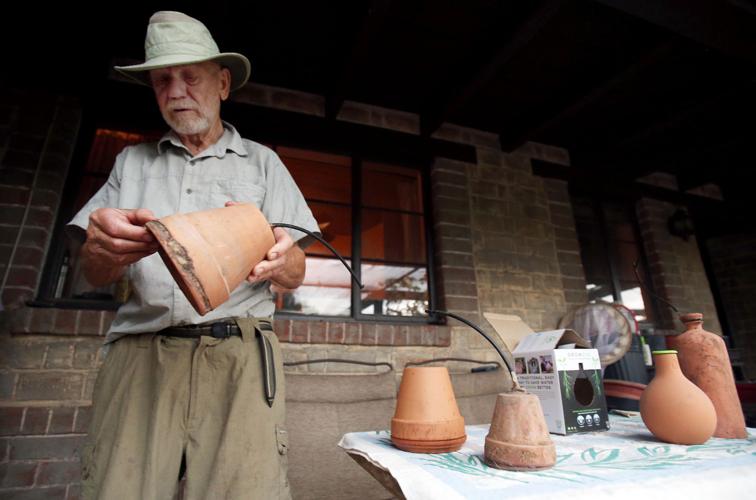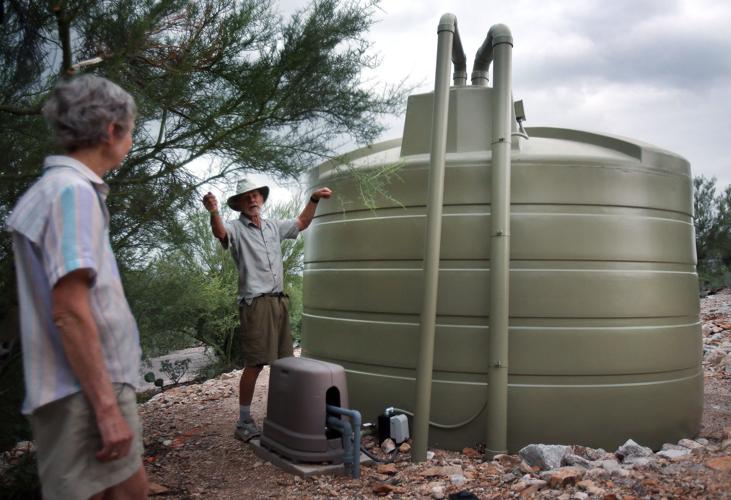Faced with ridiculously high water bills, Jennifer Hall and David Mount decided to employ some state-of-the-art technology and an ancient irrigation method to get their water use down.
And, since they’re scientists — both are retired University of Arizona molecular and cellular biology professors — they’ve turned the use of the ollas into a science project.
Their attempt to use less water started early last summer when the Foothills couple “got a water bill that was kind of on the high side,” says Hall. They realized they used about 25,000 gallons of water in the month of their highest water use.
Tucson Water residential customers use an average of 5,984 gallons of water a month, maxing out at an average of 6,732 gallons in each of the summer months, according to 2014-2015 data from the utility.
Customers with higher incomes and larger residential lots tend to use more water on average than other customers, says Tucson Water spokesman Fernando Molina.
To get to a more reasonable amount of water usage, Hunt and Mount first ripped out the water hogs in their landscape, including most of the rose bushes and fruit trees.
HIGH-TECH HARVESTING
Then they installed gutters, pumps, underground piping and two tanks that together store 5,000 gallons of collected rain water. The system allows the couple to access harvested water directly from outdoor taps. That eliminates the need to haul water from the tanks or run hoses to places that need irrigation.
The tanks are connected in a way so that Mount can use a wireless network to control how much water is in each tank. If one fills up faster than the other, water can be diverted to the one with less water. That saves every drop instead of wasting water when it overflows one tank.
The couple also installed a system to send gray water from the kitchen sink to a tank for outdoor irrigation.
OLLA EXPERIMENTS
With that high-tech system installed, the couple looked around for other ways to reduce water use for the vegetable gardens and the few rose bushes that remain.
By spring, they started experimenting with ollas, inspired by a demonstration by the Pima County master gardeners.
Mount is a master gardener and joined in growing the olla demonstration garden at the Pima County Cooperative Extension grounds. Mount decided to do further research by using ollas to solve his own irrigation challenges.
Olla, pronounced OH-yah, irrigation has been used for thousands of years. Various sources say they originated with farmers in North Africa, China and Latin America. “Olla” is Spanish for “pot.”
Made of unglazed clay, the porous olla containers are buried up to the mouth into the soil next to plants. Water is poured through the opening.
The water then seeps through the clay into the dry soil. A plant’s roots, seeking water, will grow toward and around the olla, giving it direct irrigation.
It’s a more efficient way to water plants than even water-saving drip irrigation, which waters from on the top of the soil and depends on water to seep down to the roots.
“You’re not watering the whole bed,” says Mount about ollas. “You’re just watering where the plants are.”
The gardens at both the cooperative extension and at Hall and Mount’s home are testing out a system devised by Tucson J.C. Matthews, owner of Cutting Edge Ceramics LLC. The system connects several small olla balls with tubing over the mouths. The tubing from each ball is connected to a common feeder line that connected to a reservoir.
Each ball is buried into the soil, while the tubing sticks out.
The reservoir is filled with water. Gravity moves the water from the reservoir through the tubes to the ollas.
Matthews says this “constant feed to the olla balls” reduces the need to check and fill several around the garden. “I love growing food and plants in general,” he says. “I love passive ways to do (that) with little intervention.”
Mount is experimenting with Matthews’ systems and his own, buying terracotta pots that are larger than Matthews’ olla balls.
Mount glues a saucer to the mouth of each pot and threads tubing through the pot’s drain hole. He’s also trying out ollas that are two pots glued together at their mouths.
“We’re experimenting with a combination of rainwater and ollas that would provide vegetables to people and keep it at a modest cost,” he says.
So far the couple has found that while they save in water use, it takes a lot of olla balls to water tomato plants and large vegetable beds. “If you have a big garden, it gets kind of expensive,” says Hall. Larger ollas that need to be manually filled probably will cost a bit less, she says.
MASTER GARDENER DEMO
The master gardeners also grew tomatoes with the olla ball system, comparing it with tomatoes irrigated with a drip system.
“For most of the summer they did very well,” says master gardener Pam Emerson, who works with Mount on the olla demonstration garden. “We couldn’t tell much difference between them.”
Then the extreme heat hit in June and, since master gardeners don’t tend the gardens every day, the tomatoes on the ollas took a hit.
“Had we been there on a daily basis, we probably would have supplemented the ollas a bit,” Emerson says.
The tomatoes on the drip system continue to grow.
While the master gardener demonstration was not a scientific study, the ollas did use significantly less water compared to the drip.
“The ollas basically gives the plants about a half a cup a day,” says Emerson. “That’s about six times less water than the drip.”
The demonstration garden has been torn up and the ollas put away for now, she says. By October they will try it again with cauliflower, cabbage and other winter crops.
As for Mount and Hall, their experiments continue and will include using ollas to irrigate lettuce and radishes in the fall.
With all their efforts, in less than a year they’ve reduced their water use to 11,000 gallons in the month of highest use.










